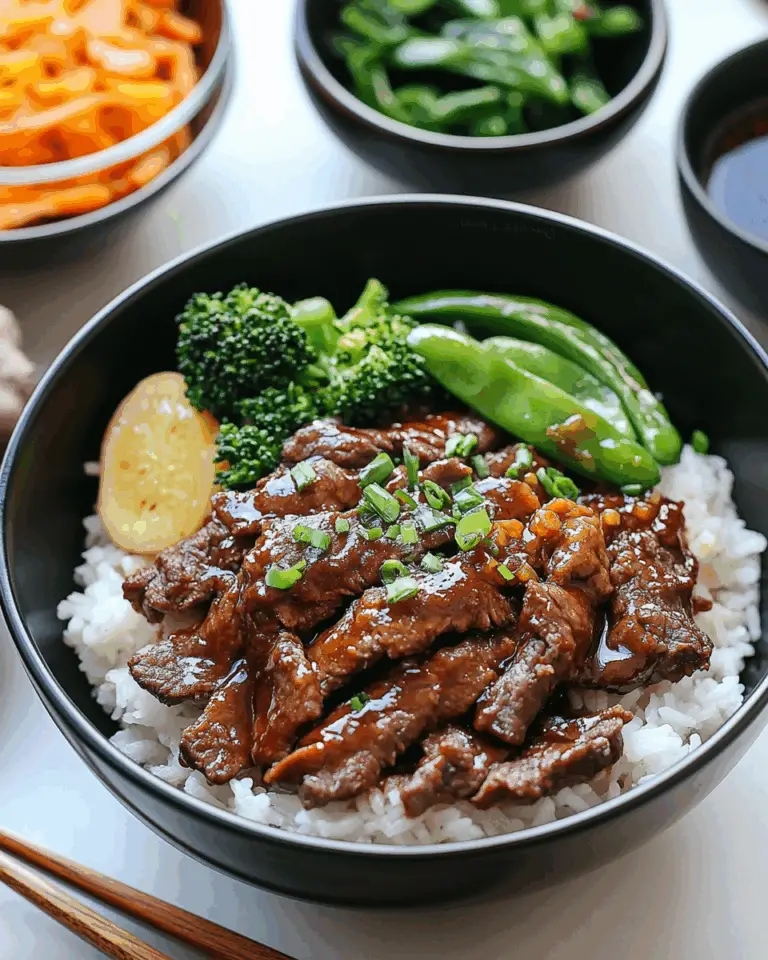The Crispy Beef Rice Bowl is a textural and flavorful masterpiece—tender, golden-brown strips of beef served over fluffy white rice, complemented by a balance of savory, sweet, and umami flavors. Aromatic garlic, ginger, and soy sauce create a fragrant stir-fry that’s fast and satisfying, perfect for busy weeknights or a quick lunch.
Full Recipe:
Ingredients
-
1 pound flank steak
-
1⁄4 cup soy sauce
-
1 tablespoon cornstarch
-
1 teaspoon sesame oil
-
1⁄4 cup brown sugar
-
1⁄4 cup water
-
1 tablespoon vegetable oil
-
3 cloves garlic, minced
-
1 teaspoon ginger, minced
-
2 cups cooked white rice
-
2 green onions, sliced
-
Sesame seeds for garnish
Directions
-
Preheat a large skillet over medium-high heat until hot.
-
Thinly slice flank steak against the grain.
-
In a bowl, whisk together soy sauce, cornstarch, sesame oil, brown sugar, and water.
-
Add beef to the marinade and let sit for at least 10 minutes.
-
Heat vegetable oil in the skillet.
-
Add garlic and ginger; cook until fragrant.
-
Add marinated steak in a single layer.
-
Cook undisturbed for 2–3 minutes to crisp up the beef.
-
Stir and cook until fully done and crispy.
-
Divide cooked rice between bowls.
-
Top with crispy beef, green onions, and sesame seeds.
-
Serve hot and enjoy!
Nutrients (estimated per serving)
-
Calories: ~400 kcal
-
Protein: ~28g
-
Fat: ~18g
-
Carbohydrates: ~35g
-
Sugar: ~10g
-
Fiber: ~1g
-
Sodium: ~900mg
Technique and Texture: The Path to Perfect Crispiness
Achieving that signature crunch begins before the steak even meets the heat. Flank steak is thinly sliced against the grain, a deliberate cut that shortens muscle fibers and produces tenderness once seared. Cornstarch in the quick marinade acts as a dry coating, absorbing surface moisture so the beef fries rather than steams, and browns faster without overcooking inside. The hot skillet or wok—preheated until wisps of smoke appear—creates instant Maillard reactions, locking juices inside and forming a deeply savory crust. By laying the beef in a single layer and resisting the urge to stir too soon, you allow caramelization to develop undisturbed for two to three crucial minutes. Only then does the stir-fry action begin, tossing the strips to finish cooking in their glossy soy-ginger reduction. The result is meat that stays succulent within but crackles at the edges, delivering contrast to every spoonful of fluffy rice.
Flavor Architecture: Balancing Sweet, Salty, and Umami
The dish’s appeal rests on a careful ratio of savory soy to mellow brown sugar. Soy sauce provides salinity and depth, enriched by the faint nuttiness of toasted sesame oil. Brown sugar, with its molasses undertone, melts into the glaze, adding body and a lacquered sheen without cloying sweetness. Aromatic garlic offers sharpness while fresh ginger contributes peppery warmth and a citrus-like lift. When these components simmer briefly with the seared beef, they reduce into a sticky coating that encapsulates all five tastes—salty, sweet, sour (from a hint of water that deglazes and concentrates), bitter (from browned edges), and the all-important umami. Finishing the bowl with sliced green onions introduces fresh, grassy notes, and a sprinkle of sesame seeds supplies nutty crunch, rounding out a fully integrated flavor profile that never feels one-dimensional.
Nutritional Perspective and Health-Forward Tweaks
One serving clocks in at approximately four hundred calories, pairing twenty-eight grams of high-quality protein with a moderate carbohydrate load from the rice. Flank steak is naturally lean, and the brief cooking time keeps added fats low—around eighteen grams in total, mainly from heart-friendly sesame and vegetable oils. Ginger and garlic contribute antioxidants such as gingerol and allicin, revered for their potential anti-inflammatory and cardiovascular benefits. Those watching sodium can opt for reduced-sodium soy or substitute half the soy sauce with coconut aminos, trimming milligrams without sacrificing depth. To boost fiber, swap part of the white rice for brown rice or quinoa, or add stir-fried vegetables like bok choy and bell peppers directly to the skillet after the beef is crisp. Even flexible low-carb plans integrate easily by serving the crispy beef atop cauliflower rice or shredded cabbage slaw, preserving the hallmark crunch while lowering net carbohydrates.
Culinary Roots and Global Reach
Stir-frying beef with soy and sugar traces its lineage to Chinese cooking traditions that valorize speed, minimal oil, and high heat to maximize flavor. Over decades the method migrated throughout East and Southeast Asia, each region layering its own accents—Korean bulgogi leans sweeter, Vietnamese shaking beef highlights black pepper and lime, while Japanese gyudon emphasizes a simmered soy dashi. The Crispy Beef Rice Bowl borrows liberally from this shared heritage yet reflects modern global palates: less sweet than bulgogi, crunchier than gyudon, and more streamlined than the wok-heavy versions found in Cantonese kitchens. The result is a hybrid bowl that feels familiar to anyone who loves takeout classics yet sufficiently new to earn a permanent spot in a home recipe rotation. Its adaptability for meal prepping, lunchboxes, or communal family dinners cements its status as an emerging comfort staple far beyond its original cultural boundaries.
Variations to Match Every Craving
Once you master the baseline technique, small tweaks open a universe of flavor riffs. Swapping flank steak for thinly sliced chicken thighs yields a lighter but equally crisp alternative, while strips of shiitake mushrooms can stand in for beef to create a vegetarian bowl rich in umami. Crushed red pepper or a dash of gochujang adds controlled heat that complements the caramel notes. For a citrusy uplift, finish the glaze with fresh orange zest or a squeeze of lime. Adventurous cooks might drizzle the final bowl with chili crisp or sriracha mayo, layering creamy richness and a jolt of spice. The rice base, too, invites creativity—try fragrant jasmine rice, nutty short-grain brown rice, or even sushi rice for a stickier texture that readily soaks up sauce. Because the recipe relies on quick cooking, substitutions rarely disturb timing, empowering you to personalize the bowl to seasonal ingredients or specific dietary goals without compromising its signature crunch.
Serving Suggestions and Meal-Prep Strategy
Presentation matters for a dish whose appeal begins with the eye. Scoop steamed rice into a warm bowl, fluffing with a fork to create valleys that capture any drips of glaze. Pile the crispy beef on top, allowing some strips to cascade over the sides for visual drama, then scatter vibrant green onions and ivory sesame seeds for color contrast. Pickled vegetables—thin ribbons of carrot or daikon lightly brined in rice vinegar—offer a tangy counterpoint that cuts through the sauce’s richness. If you’re batch-cooking for lunches, store the beef and rice separately; this preserves texture when reheating. A quick two-minute blast in a sizzling skillet revives the coating’s crackle better than microwaving. Packed in a compartmentalized container with fresh herbs or a side of kimchi, the bowl transforms into a complete, portable meal that requires no last-minute assembly.
Conclusion
The Crispy Beef Rice Bowl embodies the magic of efficient cooking: minimal ingredients, maximum return. Its success lies in the marriage of precise knife work, deliberate high-heat searing, and a balanced glaze that elevates simple staples into a crave-worthy centerpiece. Beyond taste and convenience, the bowl tells a story of culinary cross-pollination—how traditional Asian stir-fry techniques can adapt to modern lifestyles without losing soul. Whether you savor it straight from the skillet on a weeknight or meal-prep portions for busy days ahead, each serving delivers a satisfying interplay of crunch, tenderness, and layered umami that keeps you reaching for another bite. Master the method once and you gain a reliable template for endless variations, ensuring the Crispy Beef Rice Bowl will remain a beloved go-to in your kitchen repertoire for years to come.






